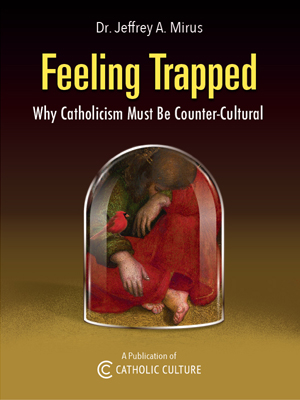The Morality of Money, 3: Money, Banking, and Inflation
By Thomas V. Mirus ( bio - articles - email ) | Nov 18, 2016
A crucial period of transition between natural and forced money in the West was the emergence of banking as we understand it today—that is, fractional-reserve banking. In The Ethics of Money Production, Hulsmann details the development of banks from mere money warehouses to money-creating and thus inflationary institutions.
Money and Banking
Historically, private coinage came before government coinage. In his treatise on money, the medieval bishop and philosopher Nicholas Oresme argued that princes did not have the right to alter coins without the consent of the entire community, for “money is the property of the commonwealth” [cit. in Hulsmann, p. 37-38]. The community can select its coinage through the use of private minters; while some individuals will always try to sneak debased coins onto the market, untrustworthy minters will quickly go out of business.
Debasement of coinage by kings or private counterfeiters was the primary means of inflation before the age of banking and paper money: a ruler might put an imprint on a coin saying that it weighed more than it really did and keep the rest for his own coffers. Yet such debasement seems almost quaint from today’s perspective:
From 1066 to 1601, the English silver pound was debased by one third. In other words, in this period stretching over more than 500 years, the English kings inflated the money supply by the factor 0.3. By contrast, in the subsequent 200-year period, which saw the emergence of modern banking, that factor was in the order of 16. And in the mere 30-year period from January 1973 to January 2003, the U.S. dollar (M1) increased almost by a factor of 5. [Hulsmann, p. 91]
How did “the emergence of modern banking” come about? The first banks were only money warehouses. Those who stored their money in the bank were given a certificate of monetary ownership, to be redeemed from the bank at any time. Since it is not always convenient to make exchanges using physical gold or silver, especially where large quantities are concerned, these certificates themselves could be exchanged, making them money substitutes. This is what banknotes originally were: certificates of ownership, representing a really existing quantity of precious metal.
Clearly such practices, though honest in themselves, increase the potential for fraud. Yet for a long time, banks were money warehouses pure and simple, until a few began to give in to the temptation to counterfeit their own banknotes by issuing more than their actual money holdings. These banknotes, rather than serving as money substitutes, were effectively new money added to the economy. A bank issuing such notes could no longer honor its promise to redeem all notes in specie at any time, as would be revealed if all its clients decided to redeem their notes at once (a “run” on the bank). This was the beginning of modern “fractional-reserve” banking, which enabled inflation on a far greater scale than before.
Inflation
There is a strong limit to how much commodity money can be added to the economy; namely, it must be dug up from the ground or otherwise found—it cannot simply be created at will. While the influx of new money does raise prices, it also satisfies demand for the commodity for other than monetary uses. Thus, it does not merely benefit the finders and lower the general purchasing power of money without raising the standard of living for anyone else.
More importantly, as Hulsmann emphasizes, while the natural increase in money supply does benefit some at the expense of others who suffer from higher prices, it does not involve violating property rights, or the implicit theft of issuing fraudulent banknotes. The same cannot be said of fiat money or the non-commodity-backed notes of fractional-reserve banks. The producers and first users of this money indeed benefit, but society as a whole does not.
It is important to realize that when new money enters the economy, the effects do not apply to the whole economy evenly all at once. In his short and lucid work on inflation and central banking, What Has Government Done to Our Money?, as well as in his comprehensive economic treatise Man, Economy and State, Murray Rothbard pointed out that money enters at a specific point in the economy, and the effects ripple outward over time. Those to whom the new money circulates are able to spend it before the rising prices (lowering purchasing power of money) take effect. But there are others in the economy who experience the higher prices before they receive the new money, at which point the real value of money has already decreased.
Thus, the producers and first users of new money benefit exclusively at the expense of those who receive it last. These last receivers include those whose income is from contracts made prior to inflation: creditors, people on fixed incomes such as teachers and ministers, people on pensions such as life insurance beneficiaries and retired persons—as Rothbard mordantly noted, quite literally the orphan and the widow.1
Inflation has sometimes been defined as any increase in the money supply, or as a general rise in prices. Yet the particular quantity of money supply is irrelevant for the purpose of monetary exchanges. Any money supply can accommodate any rate of economic growth because as the economy grows, money prices fall. Coins can always be made in smaller denominations if necessary for convenience of exchange. Thus, argues Hulsmann, a more meaningful definition of inflation is the issue of money beyond any increase in the stock of specie.
One justification for government tampering with money is the need for stable money. Yet as Hulsmann points out, there are two ways to define monetary stability. The first, stressed by Scripture (see below) and many medieval writers, is the physical integrity of commodity money. When people are free to choose their preferred currency, they can always protect against changes in the purchasing power of money (PPM) by changing to a different currency. Furthermore, no drastic depreciations in PPM have occurred with precious metals.
The second definition of stability, emphasized by writers since the seventeenth century, is that of purchasing power. As Hulsmann notes, the idea that stability of purchasing power is so overwhelmingly important that, regardless of other considerations, government must control the money supply to constantly “fine-tune” PPM “paved the way for the complete triumph of paper money” [p. 76]. Yet in the 20th century, the purchasing power of government-controlled money has fallen and fluctuated to a far greater degree than in earlier history, and the money supply has grown at a more rapid rate than it did even in the great “gold and silver inflation” of the sixteenth and seventeenth centuries.
Inflation is a dishonest and hidden (to most people) form of wealth redistribution, as Oresme pointed out:
Also it is absurd and repugnant to the royal dignity to prohibit the currency of the true and good money of the realm, and from motives of greed to command, or rather compel, subjects to use less good money; which amounts to saying that good is evil and vice versa, whereas it was said to such from the Lord, by his prophet: Woe unto them that call evil good and good evil. [cit. in Hulsmann, p. 121]
Such a form of oppression, Oresme thought, was “all the more dangerous the less obvious it is” [cit. in Hulsmann, p. 142, n. 16], because the people would not even know they were being expropriated.
The Old Testament contains numerous injunctions on the use of honest weights and measures:
Do not act dishonestly in using measures of length or weight or capacity. . . . You shall have a true scale and true weights, an honest ephah and an honest hin. I, the LORD, am your God, who brought you out of the land of Egypt. (Leviticus 19:35–36)
You shall not keep two differing weights in your bag, one large and the other small; nor shall you keep two different measures in your house, one large and the other small. But use a true and just weight, and a true and just measure, that you may have a long life on the land which the LORD, your God, is giving you. Everyone who is dishonest in any of these matters is an abomination to the LORD, your God. (Deuteronomy XXV: 13–16)
Varying weights, varying measures, are both an abomination to the LORD. [. . .] Varying weights are an abomination to the LORD, and false scales are not good. (Proverbs 20: 10, 23)
Endnotes
1. Rothbard observed elsewhere that John Maynard Keynes’s explicit goal for inflationism was the “euthanasia of the rentier,” rentiers being those living on income from accumulated property, capital and investments rather than from ongoing contributions to the economy. Yet this category includes not only the supposedly exploitative, non-contributing capitalist-investors, but anyone who lives on savings or pensions: again, the orphan and the widow.
Previous in series: Natural and Forced Money
Next in series: Manipulation by the State
The Ethics of Money Production may be purchased in hardback from its publisher, the Mises Institute, at a third of the Amazon price, or, like all of the Institute’s publications, downloaded for free as a PDF or ebook.
All comments are moderated. To lighten our editing burden, only current donors are allowed to Sound Off. If you are a current donor, log in to see the comment form; otherwise please support our work, and Sound Off!








